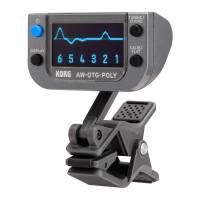- 3 -
Reference pitch settings (*M)
The default setting for the reference pitch is 440 Hz. The refer-
ence pitch can be changed.
1. Press the CALIB/FLAT button,
after which the reference pitch
appears in the display.
2. While the current setting ap-
pears in the display, press the
CALIB/FLAT button to change the reference pitch.
3. If the button is not pressed for approximately 2 seconds, the
setting is applied, and the tuner returns to tuning mode.
Flat/capo settings (*M)
Your instrument can also be tuned with all strings transposed.
This is useful when tuning using a capo or when tuning by one
to ve semitones lower than the note.
With the factory settings, “0: Normal tuning” is selected.
1. Hold down the CALIB/FLAT button for at least 1 second. The
current setting appears in the display.
2. While the current setting ap-
pears in the display, press the
CALIB/FLAT button to change
the setting between at, Drop
D and capo.
0: Normal tuning
FLAT 1: Lowered one semitone
... FLAT 5: Lowered five semi-
tones (at tuning)
D: Drop D tuning
CAPO 1: Raised one semitone
... CAPO 7: Raised seven semitones (capo support)
3. If the button is not pressed for approximately 2 seconds, the
setting is applied, and the tuner returns to tuning mode.
Identifying chords
(AW-OTG-POLY only)
The chord that is played can be identied.
1. Press the TUNING/CHORD but-
ton to enter chord-identifying
mode.
Each press of the TUNING/
CHORD button switches to
tuner mode or chord-identify-
ing mode.
2. Play a chord on your instrument. The chord appears in the
display.
Identifying a tempo
(AW-OTB-POLY only)
The tempo is identied from the baseline that is played.
1. Press the TUNING/TEMPO but-
ton to enter tempo-identifying
mode.
Each press of the TUNING/
TEMPO button switches to
tuner mode or tempo-identi-
fying mode.
2. Play your instrument at a steady rhythm in, for example,
double time or half time. The tempo appears in the display.
Setting the display type (*M)
Each press of the DISPLAY button switches the setting for the
display type.
Type 1
AW-OTG-POLY AW-OTB-POLY
Tune your instrument until the line in the display runs straight
on the reference line (dotted line). The line drops below the
reference line if the pitch is flat or rises above the reference
line if the pitch is sharp.
The pitch is at. In tune. The pitch is sharp.
Type 2
AW-OTG-POLY AW-OTB-POLY
Tune your instrument until the needle in each meter points
straight up.
The pitch is at. In tune. The pitch is sharp.
Type 3
AW-OTG-POLY AW-OTB-POLY
Tune your instrument until a perfect circle appears in the dis-
play. There is a dip in the circle if the pitch is at or a bump in
the circle if the pitch is sharp
When the 1st string
is at.
In tune.
When the 1st string
is sharp.

